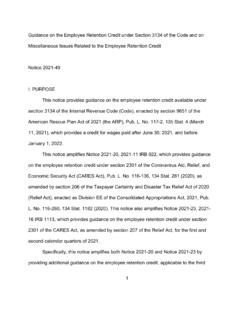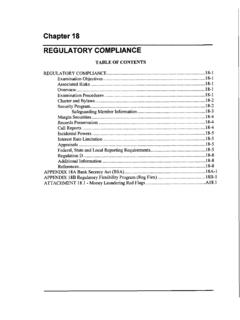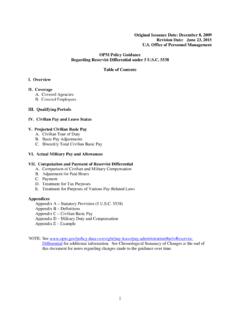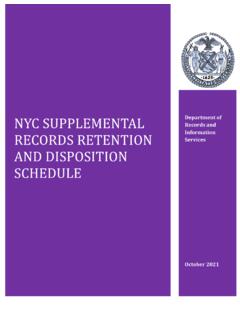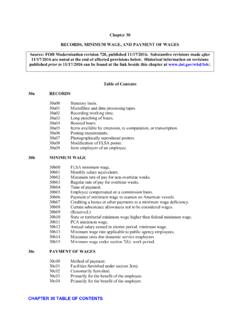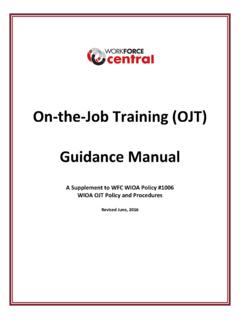Transcription of 2020 AND 2021 EMPLOYEE RETENTION CREDIT (ERC) …
1 In March 2021, the IRS issued Notice 2021-20 containing a series of FAQs to provide guidance for employers claiming the EMPLOYEE RetentionCredit for calendar quarters in 2020. Included below are references to the FAQs addressing specific areas of the 2020 ERC. The Notice addresses only 2020 ERC rules as the IRS plans to release additional guidance for 2021 ERC Notice can be found here: Notice 2021-202020 AND 2021 EMPLOYEE RETENTION CREDIT (ERC) OVERVIEWTest 1 CRITERIA (can meet either test)Test 2*Partial suspension - Business will qualify under a partial suspension of operations under governmental orders, if more than a nominal portion of itsbusiness is suspended by a governmental order. Nominal portion of business operations is defined as either i) at least 10% of the total gross receipts (determined using the gross receipts of the same calendar quarter in 2019) or ii) the hours of service performed by employees in that portion of business that are at least 10% of the total number of hours of service performed by all employees in the Employers:Q#1-Q#6-Privatesector businesses, Tax exempt organizations.
2 -Plus for ERC 2021 colleges, universities, hospitals and medical care providers-All PPP loan recipients -Available to all size employers with a trade or business Aggregationrules for Related Employers:Q#7 -Q#9 Identify membersof aggregated group treated as single employer for all aspects of ERC including total number of employees and eligibility testsAggregatedgroup:Section 52 (a), Section 52 (b)Section 414 (m) or (o)ERC 2020 -Businesshas > 50% decline in gross receipts in any calendar quarter during 2020 compared to the same quarter in 2019 Q#23 -Q#28 ERC 2021 -Business has > 20% decline in gross receipts in Q1 or Q2 of 2021 compared to the same quarter in 2019 or compare the preceding calendar quarter to the same 2019 quarterQualifiedwages only during the period governmental order was in placeERC 2020 -Qualified wages paid afterMarch 12, 2020 to December 31, 2020 -Q#30, Q#33 -Q#39Q#40 -Q#48 (for qualified health plan expenses)ERC 2021 -Qualified wages in Q1 and Q2 2021 EligibleCredit Period:ERC 2020.
3 Starting on the first day of the calendar quarter of 2020 in which there is at least 50% decline in gross receipts compared to similar quarter in 2019 Each subsequent quarter counts as a significant decline until the end of the first quarter in which gross receipts are greater than 80% of gross receipts for the same quarter in 2019. ERC 2021: starting on the first day of the calendar quarter of 2021 in which there is at least 20% decline in gross receipts compared to similar quarter in 2019; special election for ERC 2021 to use prior quarter revenue (2020 Qtr 4 and 2021 Qtr 1)Fullor partial suspension of operations due to governmental order limiting commerce, travel or group meetings due to COVID-19Q#10 Partialsuspension*:Operations are NOT comparable to pre-Covid 19; more than nominal impact on operationsQ#11 -Q#22 Eligible CREDIT Period: -period of the imposed governmental orders onlyERC 2020 ERC 2021 Determination of full-time EMPLOYEE headcount for ERC 2020 and ERC 2021 is based on the average number of full-time EMPLOYEE headcount in 2019.
4 Full-time EMPLOYEE is defined as 30 hours/week or 130 hours per month. Special rules apply if not in business in all of 2019 or starting business in 2020. This is not a full-time equivalent wages include gross wages subject to Social Security taxes and allocable group health care benefits (special rules apply for health care expense paid for laid off or furloughed employees) EXCLUDING PPP wages, FFCRA wages and wages used for other credits ( R&D, work opportunity)ERC 2020 ERC 2021 FILING FOR ERCSMALL employers receive CREDIT for ALL employees, LARGE employers receive CREDIT only for employees who were not providing WAGES AND CREDIT PERCENTAGEEMPLOYER SIZE DETERMINATION - NUMBER OF EMPLOYEES ERC 2020 ERC 2021<=100 full-time employees -SMALL> 100 full-time employees -LARGEQ#31-Q#32 Wages cap: $10,000 per EMPLOYEE per YEARC redit %: 50%Max CREDIT per EMPLOYEE : $5,000Q#29 Wages cap: $10,000per EMPLOYEE per QUARTERC redit %: 70%Max CREDIT per EMPLOYEE .
5 $14,000<= 500 full-time employees -SMALL> 500 full-time employees -LARGEC laimthe ERC by filing an amended payroll tax return using 941-X FormFile amended 941-X Form for each quarter in which the employer paid qualified wages used in the determination of rule:Employer who received PPP loan and included wages paid in the Q2 and Q3 of 2020 as payroll cost on PPP forgiveness calculation and whose request for forgiveness was denied, can claim ERC for those wages on Q4 2020 941 Form (941-X)Do not use Form 7200 Advance Payment to file for a CREDIT refund If the employer previously filed business tax return, an amended tax return will need to be filed to adjust the deduction of payroll expenses previously claimedClaimthe ERC on the quarterly Form 941 or amended 941-XForm 7200 may be filed to request an advance payment for the EMPLOYEE RETENTION CREDIT through August 2, 2021 for wagespaid through June 30, 2021.
6 If no Form 7200 is used, ERC CREDIT will be applied or refunded (if in excess of total taxes) in the quarterly 941 employers with an average of 500 or fewer full-time employees in 2019 may request advance payment of the CREDIT , subject to a limitation**, on Form 7200 after reducing depositsEligible employers should retain an amount of the employment taxes equal to the amount of their EMPLOYEE RETENTION CREDIT (andFFRCA wages)rather than depositing these amounts with the IRS . ** 7200 Form filing -Advance limitations:Amount of the advance may not exceed 70% of the average quarterly wages paid by the employer in calendar year employer who received a PPP loan may claim the ERC for any qualified wages paid to employees which were excluded from the payroll cost paid during the covered period that qualified for forgiveness under the who have previously filed for PPP loan forgiveness should consider the following for ERC calculation:The below examples provides further clarification of the guidelines:Example 1: The employer obtained a PPP loan amount of $100,000 and paid qualified wages of $100,00 that would qualify under ERC.
7 The employer filed the PPP loan forgiveness application and reported $100,000 of qualified wages as payroll cost. Loan in the amount of $100,000 was forgiven by SBA. For ERC purposes, the employer does not have any qualified wages for the ERC 2: The employer obtained a PPP loan amount of $200,000 and paid qualified wages of $250,000 that would qualify under ERC. The employer filed the PPP loan forgiveness application and reported $250,000 of qualified wages as payroll cost. Loan in the amount of $200,000 was forgiven by SBA. For ERC purposes, the employer can consider only $50,000 as qualified wages for the ERC 3: The employer obtained a PPP loan amount of $200,000 and paid qualified wages of $200,000 that would qualify under ERC and other eligible expenses of $70,000. The employer filed the PPP loan forgiveness application and reported $200,000 of qualified wages as payroll cost and did not report other eligible expenses of $70,000.
8 Loan in the amount of $200,000 was forgiven by SBA. For ERC purposes, the employer does not have any qualified wages for the ERC calculation as all qualified wages were applied to PPP loan. No other eligible expenses can be used to reduce the qualified wages previously claimed on PPP loan 4: The employer obtained a PPP loan amount of $200,000 and paid qualified wages of $200,000 that would qualify under ERC and other eligible expenses of $70,000. The employer filed the PPP loan forgiveness application and reported $200,000 of qualified wages as payroll cost and $70,000 of other eligible cost. Loan in the amount of $200,000 was forgiven by SBA. For ERC purposes, the employer can consider $70,000 as qualified wages for the ERC calculation (only $130,000 of eligible wages are considered to be allocated to PPP forgiveness).Example 5: The employer obtained a PPP loan amount of $200,000 and paid qualified wages of $200,000 that would qualify under ERC and other eligible expenses of $90,000.
9 The employer filed the PPP loan forgiveness application and reported $200,000 of qualified wages as payroll cost and $90,000 of other eligible cost. Loan in the amount of $200,000 was forgiven by SBA. For ERC purposes, the employer can consider $80,000 as qualified wages for the ERC calculation ($200,000 - $120,000 of qualified wages (60% of the loan amount minimum requirement).Example 6: The employer obtained a PPP loan amount of $200,000 and paid qualified wages of $150,000 that would qualify under ERC, $100,000 of other payroll cost that were not qualified wages and other eligible expenses of $70,000. The employer filed the PPP loan forgiveness application and reported $130,000 of payroll cost (consisting of $100,000 that is not qualified wages and $30,000 of qualified wages) and $70,000 of other eligible cost. Loan in the amount of $200,000 was forgiven by SBA.)
10 For ERC purposes, the employer can consider $120,000 as qualified wages for the ERC calculation ($150,000 of qualified wages less $30,000 of qualified wages used in PPP loan forgiveness application).Example 7: The employer obtained a PPP loan amount of $200,000 and paid qualified wages of $150,000 that would qualify under ERC, $100,000 of other payroll cost that were not qualified wages ( eligible retirement cost) and other eligible expenses of $70,000. The employer filed the PPP loan forgiveness application and reported $130,000 of payroll cost (consisting of $100,000 that is not qualified wages and $30,000 of qualified wages) and $70,000 of other eligible cost. Loan in the amount of $200,000 was NOT forgiven by SBA. For ERC purposes, the employer can consider $150,000 as qualified wages for the ERC OF QUALIFIED WAGES FOR ERC 2020 AND PPP LOAN Qualified wages included in excess of the minimum amount of payroll cost and other eligible expenses included in the PPP Loan Forgivenesscalculation, sufficient to support the amount of the PPP loan that is forgiven Qualified wages that were excluded form the PPP loan forgiveness application Qualified wages reported as payroll cost on PPP Loan Forgiveness Application that are not forgiven by SBA

